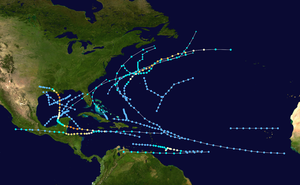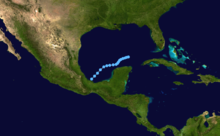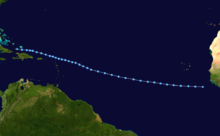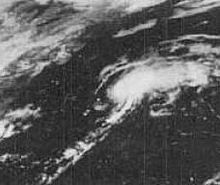User:Iune/1974

The 1974 Atlantic hurricane season is one of the deadliest Atlantic hurricane seasons with more than 6,000 dead.[1] During the season, twenty tropical or subtropical depressions formed, of which eleven reached tropical storm intensity.[2][3] Four of those tropical storms became hurricanes and two of those became major hurricanes.[2] The season officially began on June 1, 1974 and ended on November 30. These dates typically limit the period of each year when most tropical cyclones form in the eastern North Atlantic hurricane basin. This timeline documents all the storm formations, strengthening, weakening, landfalls, extratropical transitions, as well as dissipation. The timeline also includes information which was not operationally released, meaning that information from post-storm reviews by the National Hurricane Center, such as information on a storm that was not operationally warned on, has been included.
The first storm of the season, Tropical Depression One, formed on June 22. The final storm of the season, Tropical Depression Seventeen, dissipated on November 11. There were twenty tropical cyclones during the season. Of these, four were subtropical storms, and sixteen were tropical. Of these tropical systems, four became hurricanes; two of those reached Category 3 intensity or higher on the Saffir-Simpson hurricane scale. Hurricane Carmen threatened two major cities during its duration, Belize City, Belize and New Orleans, Louisiana, but veered away at the last moment.[4] Hurricane Fifi is among the deadliest storms in the Atlantic Basin with fatality estimates ranging from 6,000 to 8,000.[1]
Timeline of Recent Events[edit]

June[edit]

- June 1
- The 1974 Atlantic hurricane season officially begins.[5]
- June 22
- 12:00 UTC (7:00 a.m. CDT) - Tropical Depression One forms roughly 75 mi (120 km)[nb 1] southwest of Veracruz, Mexico.[6]
- June 23
- 00:00 UTC (7:00 p.m. CDT, June 22) - Tropical Depression One attains its peak intensity with winds of 30 mph (50 km/h).[6]

- June 24
- 18:00 UTC (1:00 p.m. CDT) - Subtropical Depression One[nb 2] forms roughly 205 mi (330 km) northwest of Cancún, Mexico, or about 165 mi (265 km) northeast of Tropical Depression One.[6]
- June 25
- 00:00 UTC (7:00 p.m. CDT, June 24) - Subtropical Depression One intensifies into a subtropical storm.[6]
- 06:00 UTC (2:00 a.m. EDT) - Subtropical Storm One makes landfall near Clearwater, Florida with winds of 50 mph (85 km/h).[6]
- 12:00 UTC (8:00 a.m. EDT) - Subtropical Storm One attains its peak intensity with winds of 65 mph (105 km/h) and a minimum barometric pressure of 1000 mb (hPa; 29.53 inHg) while over Florida.[6]
- June 26
- 00:00 UTC (8:00 p.m. EDT, June 25) - Subtropical Storm One becomes extratropical roughly 150 mi (240 km) southeast of Wilmington, North Carolina.[6]
- 12:00 UTC (7:00 a.m. CDT) - Tropical Depression One dissipates roughly 160 mi (260 km) northwest of Cancún, Mexico.[6]
July[edit]
- July 13
- 12:00 UTC (7:00 a.m. CDT) - Tropical Depression Two forms roughly 135 mi (220 km) south of Pensacola, Florida.[6]
- July 15
- 12:00 UTC (7:00 a.m. CDT) - Tropical Depression Two attains its peak intensity with winds of 35 mph (55 km/h).[6]

- July 16
- 00:00 UTC (8:00 p.m. EDT, July 15) - Subtropical Depression Two forms roughly 365 mi (590 km) east of Daytona Beach, Florida.[6]
- July 17
- 12:00 UTC (8:00 a.m. EDT) Subtropical Depression Two intensifies into a subtropical storm.[6]
- 18:00 UTC (1:00 p.m. CDT) - Tropical Depression Two makes landfall near Galveston, Texas with winds of 30 mph (50 km/h) and dissipates.[6]
- July 18
- 12:00 UTC (8:00 a.m. EDT) - Subtropical Storm Two attains its peak intensity with winds of 50 mph (80 km/h) and a minimum barometric pressure of 1006 mb (hPa; 29.71 inHg).[6]
- July 20
- 00:00 UTC (8:00 p.m. AST, July 19) - Subtropical Storm Two becomes extratropical roughly 255 mi (415 km) southeast of St John's, Newfoundland and Labrador.[6]
- July 31
- 12:00 UTC (8:00 a.m. AST) - Tropical Depression Three forms roughly 270 mi (430 km) northwest of Praia, Cape Verde Islands.[6]
August[edit]

- August 1
- 06:00 UTC (2:00 a.m. AST) - Tropical Depression Three attains its peak intensity with winds of 35 mph (55 km/h).[6]
- August 2
- 12:00 UTC (8:00 a.m. AST) - Tropical Depression Three dissipates roughly 855 mi (1,375 km) northwest of Praia, Cape Verde Islands.[6]
- August 10
- 12:00 UTC (8:00 a.m. EDT) - Subtropical Storm Three forms roughly 255 mi (410 km) southeast of Atlantic City, New Jersey.[6]
- August 12
- 12:00 UTC (8:00 a.m. AST) - Tropical Depression Four forms roughly 905 mi (1,455 km) northeast of Belém, Brazil.[6]
- August 13
- 12:00 UTC (8:00 a.m. AST) - Tropical Depression Four intensifies into a tropical storm and is named "Alma".[6]
- 18:00 UTC (2:00 p.m. AST) - Tropical Storm Alma attains its peak intensity with winds of 65 mph (100 km/h) and a minimum barometric pressure of 1007 mb (hPa; 29.74 inHg).[6]

- August 14
- 12:00 UTC (8:00 a.m. EDT) - Subtropical Storm Three attains its peak intensity with winds of 60 mph (95 km/h) and a minimum barometric pressure of 992 mb (hPa; 29.30 inHg).[6]
- 12:00 UTC (8:00 a.m. EDT) - Tropical Storm Alma makes its first landfall on Trinidad with winds of 45 mph (70 km/h).[6]
- 18:00 UTC (2:00 p.m. EDT) - Tropical Storm Alma makes its second landfall on Venezuela's Paria Peninsula with winds of 40 mph (65 km/h).[6]
- August 15
- 06:00 UTC (2:00 a.m. EDT) - Subtropical Storm Three is absorbed by a frontal boundary roughly 195 mi (315 km) southeast of Halifax, Nova Scotia.[6]
- 06:00 UTC (2:00 a.m. EDT) - Tropical Storm Alma makes its third, and final landfall near Higuerote, Venezula with winds of 40 mph (65 km/h).[6]
- 12:00 UTC (8:00 a.m. EDT) - Tropical Storm Alma dissipates over the mountains of Venezuela.[6]
- August 24
- 12:00 UTC (7:00 a.m. CDT) - Tropical Depression Five forms roughly 215 mi (345 km) northwest of Havana, Cuba.[6]
- August 25
- 06:00 UTC (1:00 a.m. CDT) - Tropical Depression Five attains its peak intensity with winds of 35 mph (55 km/h).[6]
- August 26
- 12:00 UTC (7:00 a.m. CDT) - Tropical Depression Five makes landfall near Galveston, Texas with winds of 30 mph (50 km) and dissipates.[6]
- 12:00 UTC (8:00 a.m. EDT) - Tropical Depression Six forms roughly 515 mi (830 km) northeast of Nassau, Bahamas.[6]
- August 28
- 06:00 UTC (2:00 a.m. EDT) - Tropical Depression Six intensifies into a tropical storm and is named "Becky".[6]
- 18:00 UTC (2:00 p.m. EDT) - Tropical Storm Becky intensifies into a category 1 hurricane.[6]

- August 29
- 06:00 UTC (2:00 a.m. EDT) - Tropical Depression Seven forms roughly 375 mi (600 km) northeast of Guadeloupe.[6]
- 12:00 UTC (8:00 a.m. EDT) - Hurricane Becky intensifies into a category 2 hurricane.[6]
- August 30
- 06:00 UTC (2:00 a.m. EDT) - Hurricane Becky intensifies into a category 3 hurricane, the first major hurricane of the 1974 season. Simultaneously, the storm attains its peak intensity with winds of 115 mph (185 km/h).[6]
- 12:00 UTC (8:00 a.m. EDT) - Hurricane Becky attains its peak intensity with a minimum barometric pressure of 977 mb (hPa; 28.85 inHg).[6]
- 12:00 UTC (8:00 a.m. EDT) - Tropical Depression Seven intensifies into a tropical storm and is named "Carmen".[6]
- August 31
- 12:00 UTC (8:00 a.m. EDT) - Tropical Storm Carmen intensifies into a category 1 hurricane.[6]
- 18:00 UTC (2:00 p.m. EDT) - Hurricane Becky weakens into a category 2 hurricane.[6]
September[edit]

- September 1
- 06:00 UTC (2:00 a.m. EDT) - Hurricane Carmen intensifies into a category 2 hurricane.[6]
- 12:00 UTC (8:00 a.m. AST) - Hurricane Becky weakens into a category 1 hurricane.[6]
- 12:00 UTC (8:00 a.m. EDT) - Hurricane Carmen intensifies into a category 3 hurricane.[6]
- 18:00 UTC (2:00 p.m. EDT) - Hurricane Carmen intensifies into a category 4 hurricane.[6]
- September 2
- 00:00 UTC (8:00 p.m. AST, September 1) - Hurricane Becky weakens into a tropical storm.[6]
- 06:00 UTC (2:00 a.m. AST) - Tropical Storm Becky dissipates roughly 565 mi (910 km) northwest of Angra do Heroísmo, Azores.[6]
- 06:00 UTC (2:00 a.m. EDT) - Hurricane Carmen attains its peak intensity with winds of 150 mph (240 km/h) and a minimum barometric pressure of 928 mb (hPa; 27.41 inHg).[6]
- 12:00 UTC (8:00 a.m. EDT) - Hurricane Carmen makes its first landfall near Chetumal, Mexico with winds of 140 mph (220 km/h).[6]
- 18:00 UTC (2:00 p.m. EDT) - Hurricane Carmen weakens into a category 2 hurricane.[6]
- September 3
- 00:00 UTC (8:00 p.m. EDT, September 2) - Hurricane Carmen weakens into a tropical storm.[6]
- September 5
- 12:00 UTC (7:00 a.m. CDT) - Tropical Storm Carmen re-intensifies into a category 1 hurricane.[6]

- September 6
- 18:00 UTC (1:00 p.m. CDT) - Hurricane Carmen re-intensifies into a category 2 hurricane.[6]
- September 7
- 00:00 UTC (7:00 p.m. CDT, September 6) - Hurricane Carmen re-intensifies into a category 3 hurricane.[6]
- 18:00 UTC (1:00 p.m. CDT) - Hurricane Carmen re-intensifies into a category 4 hurricane.[6]
- September 8
- 00:00 UTC (7:00 p.m. CDT, September 7) - Hurricane Carmen re-attains its peak intensity with winds of 150 mph (240 km/h).[6]
- 06:00 UTC (1:00 a.m. CDT) - Hurricane Carmen weakens into a category 3 hurricane. Simultaneously, the storm makes its second landfall near Morgan City, Louisiana with winds of 120 mph (195 km/h).[6]
- 18:00 UTC (1:00 p.m. CDT) - Hurricane Carmen weakens into a tropical storm.[6]
- September 9
- 00:00 UTC (7:00 p.m. CDT, September 8) - Tropical Storm Carmen weakens into a tropical depression.[6]
- September 10
- September 2
- September 3
-
- 1800 UTC (2 p.m. EDT) - Tropical Depression Nine in the central Atlantic strengthens into a tropical storm and is named Dolly. At the same time, it reaches its peak intensity of 50 mph (85 km/h).[7]
- September 4
-
- 1800 UTC (2 p.m. EDT) - Tropical Depression Ten forms in the central Atlantic Ocean.[8]

- September 5
-
- 1200 UTC (8 a.m. EDT) - Tropical Storm Dolly becomes extratropical in the frigid waters of the North Atlantic.[7]

- September 9
-
- 1800 UTC (2 p.m. EDT) - Tropical Depression Ten strengthens into a tropical storm and is named Elaine.[8]
- September 10
-
- 1200 UTC (8 a.m. EDT) - Tropical Storm Elaine reaches its peak intensity of 70 mph (110 km/h).[8]
- September 11
-
- 1200 UTC (8 a.m. EDT) - Tropical Depression Eight makes landfall of Great Inagua Island in the Bahamas and dissipates.[3]
- September 14
-
- 0000 UTC (8 p.m. EDT September 13) - Tropical Storm Elaine becomes extratropical in the cold waters of the North Atlantic Ocean.[8]
- 1200 UTC (8 a.m. EDT) - Tropical Depression Eleven forms in the Caribbean Sea just south of Puerto Rico.[9]

- September 16
-
- 1800 UTC (2 p.m. EDT) - Tropical Depression Eleven strengthens into a tropical storm and is named Fifi.[9]
- September 17
-
- 0600 UTC (2 a.m. EDT) - Tropical Storm Fifi becomes a hurricane.[9]
- September 18
-
- 0600 UTC (2 a.m. EDT) - Hurricane Fifi strengthens into a category 2 hurricane.[9]
- 1200 UTC (8 a.m. EDT) - Tropical Depression Twelve forms in the central Atlantic Ocean.[3]
- 1800 UTC (1 p.m. CDT) - Hurricane Fifi reaches its peak intensity of 110 mph (180 km/h) while paralleling the Honduran coastline.[9]
- September 20
-
- 0000 UTC (7 p.m. CDT September 19) - Hurricane Fifi makes landfall at the base of the Yucatan Peninsula in Guatemala with winds of 105 mph (170 km/h) and weakens into a tropical storm.[9]
- 1800 UTC (1 p.m. CDT) - Tropical Storm Fifi weakens into a tropical depression.[9]
- 1800 UTC (2 p.m. EDT) - Tropical Depression Twelve dissipates northwest of Bermuda.[3]
- September 22
-
- 1200 UTC (4 a.m. PDT) - Tropical Depression Fifi restrengthens into a tropical storm in the Pacific Ocean. Following policy at the time, it is renamed Orlene.[9]
- September 23
-
- 1200 UTC (8 a.m. EDT) - Tropical Depression Thirteen forms in the western Caribbean Sea.[3]
- September 27
-
- 1200 UTC (8 a.m. EDT) - Tropical Depression Fourteen forms east of the Lesser Antilles.[10]
- 1200 UTC (8 a.m. EDT) - Tropical Depression Thirteen dissipates just south of Cedar Key, Florida.[3]
- September 28
-
- 1800 UTC (2 p.m. EDT) - Tropical Depression Fourteen strengthens into a tropical storm and is named Gertrude.[10]
- September 29
-
- 0000 UTC (8 p.m. EDT September 28) - Tropical Storm Gertrude rapidly strengthens into a hurricane and reaches its peak intensity of 75 mph (120 km/h).[10]
- September 30
-
- 1800 UTC (2 p.m. EDT) - Hurricane Gertrude weakens into a tropical storm.[10]
October[edit]
- October 2
-
- 1200 UTC (8 a.m. EDT) - Tropical Storm Gertrude weakens into a tropical depression.[10]
- 1800 UTC (2 p.m. EDT) - Tropical Depression Gertrude makes landfall on Carriacou Island in the Grenadines with winds of 35 mph (55 km/h).[10]
- October 4

- October 5
-
- 1200 UTC (8 a.m. EDT) - Tropical Depression Fifteen becomes subtropical.[11]
- October 6
-
- 0000 UTC (8 p.m. EDT October 5) - The subtropical depression that used to be Tropical Depression Fifteen strengthens into a subtropical storm and is numbered Four.[11]
- 0600 UTC (2 a.m. EDT) - Subtropical Storm Four makes landfall on Grand Bahama Island with winds of 45 mph (70 km/h).[11]
- October 7
-
- 0000 UTC (8 p.m. EDT October 6) - Subtropical Storm Four reaches its peak intensity of 50 mph (80 km/h).[11]
- October 8
-
- 1200 UTC (8 a.m. EDT) - Subtropical Storm Four weakens into a subtropical depression and becomes extratropical.[11]
- October 30
-
- 1200 UTC (8 a.m. EDT) - Tropical Depression Sixteen forms in the central Atlantic Ocean.[3]
November[edit]
- November 2
-
- 1200 UTC (8 a.m. EDT) - Tropical Depression Sixteen dissipates.[3]
- November 10
-
- 1200 UTC (8 a.m. EDT) - Tropical Depression Seventeen forms north of the Dominican Republic.[3]
- November 12
-
- 1200 UTC (8 a.m. EDT) - Tropical Depression Seventeen dissipates.[3]
- November 30
-
- The 1974 Atlantic hurricane season officially ends.[5]
See also[edit]
Footnotes[edit]
- ^ The figures for maximum sustained winds and position estimates are rounded to the nearest 5 units (knots, miles, or kilometers), following the convention used in the National Hurricane Center's operational products for each storm. All other units are rounded to the nearest digit.
- ^ During the 1974 Atlantic hurricane season, tropical cyclones and subtropical cyclones were numbered independently of each other.
References[edit]
- ^ a b Rappaport, Edward N. (May 28, 1995 (updated April 22, 1997)). "Deadliest Atlantic Tropical Cyclones 1492–1996". National Oceanic Atmospheric Administration. Retrieved 2009-06-17.
{{cite web}}: Check date values in:|date=(help); Unknown parameter|coauthors=ignored (|author=suggested) (help) - ^ a b c "Atlantic Tropical Cyclones 1851–2008". Atlantic Basin Hurricane Database. Retrieved 2009-06-17.
- ^ a b c d e f g h i j k Cite error: The named reference
TDwas invoked but never defined (see the help page). - ^ "Season Summary for 1974" (PDF). US Weather Service. Retrieved 2009-06-17.
- ^ a b Atlantic Oceanographic and Meteorological Laboratory, Hurricane Research Division. "Frequently Asked Questions: When is hurricane season?". NOAA. Retrieved 2008-08-21.
- ^ a b c d e f g h i j k l m n o p q r s t u v w x y z aa ab ac ad ae af ag ah ai aj ak al am an ao ap aq ar as at au av aw ax ay az ba bb bc bd be bf bg "Atlantic Hurricane Database (HURDAT2) (1851-2013)". National Hurricane Center. May 27, 2014. Retrieved July 18, 2014.
- ^ a b c "HURDAT Best Track for Tropical Storm Dolly". Atlantic Basin Hurricane Database. Retrieved 2009-06-05.
- ^ a b c d "HURDAT Best Track for Tropical Storm Elaine". Atlantic Basin Hurricane Database. Retrieved 2009-06-17.
- ^ a b c d e f g h "HURDAT Best Track Data for Hurricane Fifi". Atlantic Basin Hurricane Database. Retrieved 2009-06-17.
- ^ a b c d e f g "HURDAT Best Track for Hurricane Gertrude". Atlantic Basin Hurricane Database. Retrieved 2009-06-17.
- ^ a b c d e f "HURDAT Best Track for Subtropical Storm Four". Atlantic Basin Hurricane Database. Retrieved 2009-06-17.
